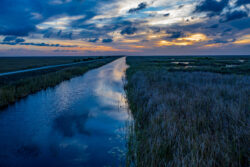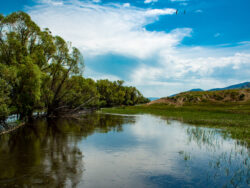Floods in landlocked Montana are not completely unheard of. The most severe floods can be expected in the southwestern portion of the state. Albeit rare, flooding in Montana has happened before. For instance, in 2014, snowmelt caused a state of emergency in the Fort Belknap Indian Reservation, the Town of Chester, and Pondera, Hill, Blaine, Valley, Toole, Liberty, and Petroleum Counties.
Beverhead and Gallatin county, and Missoula to Cascade are the regions which experience more intense flooding. If you’d like to see the flood risk of your property, click here. Montana Flood Factor allows you to see the risk of flooding across the state, and how severe that risk is. Although the snow has yet to start melting this year, I think it’s a good idea to get some safety precautions locked in just in case.

Levee, Dike and Culvert
When analyzing your property or town for potential flood risks, it’s valuable to know what precautions are typically taken in Montana. The top 3 adaptation measures in Montana are putting levees, dikes and culverts in place. A levee is an embankment that prevents the overflow onto the mainland. These are typically built alongside rivers, parallel to the water.
Dikes are of the same vein, upraised sections of land that prevent flooding by acting as a barrier.
Culverts are tunnels or open drains that carry water underneath roads in order to relocate it. This eases flooding by controlling where excess water goes.
Heavy Rain
Because Montana is landlocked, it’s less likely that repercussions from hurricanes will cause any sort of flooding here. A huge factor to be monitoring is the amount of rain and how quickly it’s accumulating. This is the most likely cause of a surge in the rivers and lakes that would lead to a flood event. If you notice heavy rains over a long period of time, it’s worth checking the flood reports in your area.

Check Your Insurance
If you do your research and you know that you live in a high-risk area. Whether you’re alongside a river or body of water, checking to see if your insurance entails flood coverage would be valuable. It won’t be a given in a lot of insurance policies in Montana, because of the unlikelihood of hurricane impact.
Secure Your Home
If you’ve done your research, think your home may be at risk you can take steps to protect it. You can start by checking to see if there’s any external cracks in the foundation, gaps or holes that could allow water to leak into your home.
Next, examine the lower levels of your homes, such as the cellar, to make sure the windows and walls are sealed from the outside world. Proper drainage around your home will be important, as well as checking the local storm drains for debris or blockages. Checking your insulation, seals on your doors and windows, and drainage systems is the best way to ready your property for a flood. If you live along a river, building a levee, dike or culvert could be effective as well.
At the end of the day, the likelihood of a massive flood in Montana is low. However, knowing what you’re up against and the best safety precautions to take can’t hurt. Once you seal and secure your place, you can spend time Fishing in the Flood Waters, as Rowdy Rob wrote about in 2016.